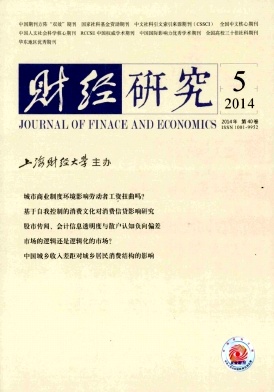出口真的是多多益善吗?——基于广义倾向得分匹配的再估计
财经研究 2014 年 第 40 卷第 05 期, 页码:100 - 111
摘要
参考文献
摘要
生产率是一个企业得以持续发展的内在动力。文章利用2000-2007年工业企业数据库中企业层面数据,采用广义倾向得分匹配方法分析出口强度与企业生产率之间的关系。研究结果表明:出口强度与企业生产率之间存在"倒U形"的关系,即企业生产率随着出口强度的增加先上升后下降;进一步地,我们考察了出口强度对企业生产率的动态影响,发现"倒U形"的关系仍然存在,但是出口强度对于企业生产率的影响会随着时间的推移而递减。
[1]戴觅,余淼杰.企业出口前研发投入、出口及生产率进步——来自中国制造业企业的证据[J].经济学(季刊),2012,(1):211-230.
[2]范剑勇,冯猛.中国制造业出口企业生产率悖论之谜:基于出口密度差别上的检验[J].管理世界,2013,(8):16-29.
[3]李春顶,赵美英.出口贸易是否提高了我国企业的生产率?——基于中国2007年制造业企业数据的检验[J].财经研究,2010,(4):14-24.
[4]邱斌,刘修岩,赵伟.出口学习抑或自选择:基于中国制造业微观企业的倍差匹配检验[J].世界经济,2012,(4):23-40.
[5]钱学锋,王菊蓉,黄云湖,等.出口与中国工业企业的生产率——自我选择效应还是出口学习效应?[J].数量经济技术经济研究,2011,(2):37-51.
[6]田巍,余淼杰.企业出口强度与进口中间品贸易自由化:来自中国企业的实证研究[J].管理世界,2013,(1):28-44.
[7]谢千里,罗斯基,张轶凡.中国工业生产率的增长与收敛[J].经济学(季刊),2008,(3):809-826.
[8]张杰,李勇,刘志彪.出口促进中国企业生产率提高吗?——来自中国本土制造业企业的经验证据:1999-2003[J].管理世界,2009,(12):11-26.
[9]朱希伟,金祥荣,罗德明.国内市场分割与中国的出口贸易扩张[J].经济研究,2005,(12):68-76.
[10]Alvarez R,Lopez R.Exporting and performance:Evidence from Chilean plants[J].Canadian Journal of Economic,2005,38(4):1384-1400.
[11]Bernard A B,Jensen J B,Lawrence R Z.Exporters,jobs,and wages in US manufacturing:1976-1987[R].Bookings Papers on Economic Activity,Microeconomics,1995.
[12]Bernard A B,Wagner J.Exports and success in German manufacturing[J].Review of World Economics,1997,133(1):134-157.
[13]Cai H,Liu Q.Competition and corporate tax avoidance:Evidence from Chinese industrial firms[J].The Economic Journal,2009,119(537):764-795.
[14]Castellani D.Export behavior and productivity growth:Evidence from Italian manufacturing firms[J].Review of World Economics,2002,138(4):605-628.
[15]Clerides S K,Lach S,Tybout J R.Is learning by exporting important?Micro-dynamic evidence from Colombia,Mexico,and Morocco[J].The Quarterly Journal of Economics,1998,113(3):903-947.
[16]Eaton J,Kortum S,Kramarz F.An anatomy of international trade:Evidence from French firms[J].Econometrica,2011,79(5):1453-1498.
[17]He D,Zhang W.How dependent is the Chinese economy on exports and in what sense has its growth been export-led[J].Journal of Asian Economics,2010,21(1):87-104.
[18]Hirano K,Imbens G W.The propensity score with continuous treatments[J].Applied Bayesian Modeling and Causal Inference from Incomplete Data Perspectives,2004:73-84.
[19]Imbens G W.The role of the propensity score in estimating dose-response functions[J].Biometrika,2000,87(3):706-710.
[20]Liu J,Tsou M,Hammitt J K.Export activity and productivity:Evidence from the Taiwan electronics industry[J].Review of Word Economics,1999,135(4):675-691.
[21]Manjón,M,Ma珘nez J A,Rochina-Barrachina M E,et al.Export intensity and the productivity gains of exporting[J].Applied Economics Letters,2013,20(8):804-808.
[22]McCullagh P,Nelder J A.Generalized linear models[M].New York:Chapman&Hall/CRC,1989.
[23]Melitz M J.The impact of trade on intra-industry reallocations and aggregate industry productivity[J].Econometrica,2003,71(6):1695-1725.
[24]Papke L E,Wooldridge J M.Econometric methods for fractional response variables with an application to401(K)Plan Participation Rates[J].Journal of Applied Econometrics,1996,11(6):619-632.
[25]Wagner J.A note on the firm size-export relationship[J].Small Business Economics,2001,17(4),229-237.
[26]Wagner J.Unobserved firm heterogeneity and the size-export nexus:Evidence from German panel data[J].Review of World Economics,2003,139(1):161-172.
①文章中没有列出去掉纯出口企业后各年的“剂量反应”函数,感兴趣的读者可以联系作者索取。
①由于出口强度对于企业未来第三期生产率的影响与未来第二期是类似的,限于文章的篇幅,我们没有在文章中列出。
[2]范剑勇,冯猛.中国制造业出口企业生产率悖论之谜:基于出口密度差别上的检验[J].管理世界,2013,(8):16-29.
[3]李春顶,赵美英.出口贸易是否提高了我国企业的生产率?——基于中国2007年制造业企业数据的检验[J].财经研究,2010,(4):14-24.
[4]邱斌,刘修岩,赵伟.出口学习抑或自选择:基于中国制造业微观企业的倍差匹配检验[J].世界经济,2012,(4):23-40.
[5]钱学锋,王菊蓉,黄云湖,等.出口与中国工业企业的生产率——自我选择效应还是出口学习效应?[J].数量经济技术经济研究,2011,(2):37-51.
[6]田巍,余淼杰.企业出口强度与进口中间品贸易自由化:来自中国企业的实证研究[J].管理世界,2013,(1):28-44.
[7]谢千里,罗斯基,张轶凡.中国工业生产率的增长与收敛[J].经济学(季刊),2008,(3):809-826.
[8]张杰,李勇,刘志彪.出口促进中国企业生产率提高吗?——来自中国本土制造业企业的经验证据:1999-2003[J].管理世界,2009,(12):11-26.
[9]朱希伟,金祥荣,罗德明.国内市场分割与中国的出口贸易扩张[J].经济研究,2005,(12):68-76.
[10]Alvarez R,Lopez R.Exporting and performance:Evidence from Chilean plants[J].Canadian Journal of Economic,2005,38(4):1384-1400.
[11]Bernard A B,Jensen J B,Lawrence R Z.Exporters,jobs,and wages in US manufacturing:1976-1987[R].Bookings Papers on Economic Activity,Microeconomics,1995.
[12]Bernard A B,Wagner J.Exports and success in German manufacturing[J].Review of World Economics,1997,133(1):134-157.
[13]Cai H,Liu Q.Competition and corporate tax avoidance:Evidence from Chinese industrial firms[J].The Economic Journal,2009,119(537):764-795.
[14]Castellani D.Export behavior and productivity growth:Evidence from Italian manufacturing firms[J].Review of World Economics,2002,138(4):605-628.
[15]Clerides S K,Lach S,Tybout J R.Is learning by exporting important?Micro-dynamic evidence from Colombia,Mexico,and Morocco[J].The Quarterly Journal of Economics,1998,113(3):903-947.
[16]Eaton J,Kortum S,Kramarz F.An anatomy of international trade:Evidence from French firms[J].Econometrica,2011,79(5):1453-1498.
[17]He D,Zhang W.How dependent is the Chinese economy on exports and in what sense has its growth been export-led[J].Journal of Asian Economics,2010,21(1):87-104.
[18]Hirano K,Imbens G W.The propensity score with continuous treatments[J].Applied Bayesian Modeling and Causal Inference from Incomplete Data Perspectives,2004:73-84.
[19]Imbens G W.The role of the propensity score in estimating dose-response functions[J].Biometrika,2000,87(3):706-710.
[20]Liu J,Tsou M,Hammitt J K.Export activity and productivity:Evidence from the Taiwan electronics industry[J].Review of Word Economics,1999,135(4):675-691.
[21]Manjón,M,Ma珘nez J A,Rochina-Barrachina M E,et al.Export intensity and the productivity gains of exporting[J].Applied Economics Letters,2013,20(8):804-808.
[22]McCullagh P,Nelder J A.Generalized linear models[M].New York:Chapman&Hall/CRC,1989.
[23]Melitz M J.The impact of trade on intra-industry reallocations and aggregate industry productivity[J].Econometrica,2003,71(6):1695-1725.
[24]Papke L E,Wooldridge J M.Econometric methods for fractional response variables with an application to401(K)Plan Participation Rates[J].Journal of Applied Econometrics,1996,11(6):619-632.
[25]Wagner J.A note on the firm size-export relationship[J].Small Business Economics,2001,17(4),229-237.
[26]Wagner J.Unobserved firm heterogeneity and the size-export nexus:Evidence from German panel data[J].Review of World Economics,2003,139(1):161-172.
①文章中没有列出去掉纯出口企业后各年的“剂量反应”函数,感兴趣的读者可以联系作者索取。
①由于出口强度对于企业未来第三期生产率的影响与未来第二期是类似的,限于文章的篇幅,我们没有在文章中列出。
引用本文
陈勇兵, 王晓伟, 符大海, 等. 出口真的是多多益善吗?——基于广义倾向得分匹配的再估计[J]. 财经研究, 2014, 40(5): 100–111.
导出参考文献,格式为:





 6882
6882  3680
3680

